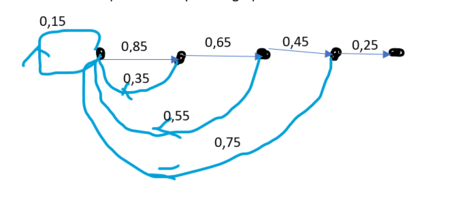Mister_JWO
New member
- Joined
- Oct 19, 2022
- Messages
- 7
Hello everyone
During class our math teacher gave us an extra exercise to make this week. We can use every source we want to find the solution. Can someone help me with the work method to solve this problem?
A man is participating in a television program. He has to follow a way and on 4 points he has to do a task. When he fails a task he has to go back to point 1. On the first point he has 85% chance to succeed, on the second point 65%, on the third point 45% and on the fourth point he has 25% chance to succeed. When he has passed the fourth point he wins. How much task has the man in average to do before he wins?
I’ve put it already into a graph to make it more visual:
Thank you very much.
During class our math teacher gave us an extra exercise to make this week. We can use every source we want to find the solution. Can someone help me with the work method to solve this problem?
A man is participating in a television program. He has to follow a way and on 4 points he has to do a task. When he fails a task he has to go back to point 1. On the first point he has 85% chance to succeed, on the second point 65%, on the third point 45% and on the fourth point he has 25% chance to succeed. When he has passed the fourth point he wins. How much task has the man in average to do before he wins?
I’ve put it already into a graph to make it more visual:
Thank you very much.

